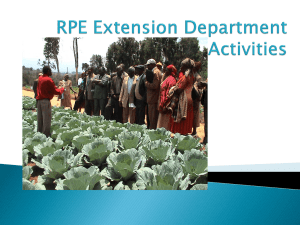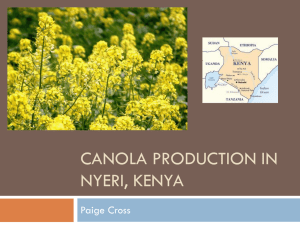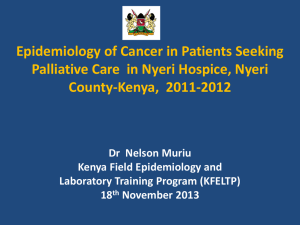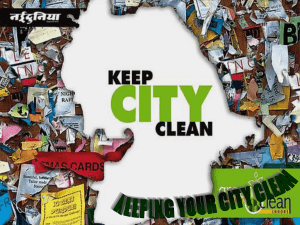The Municipal Council of Nyeri
advertisement
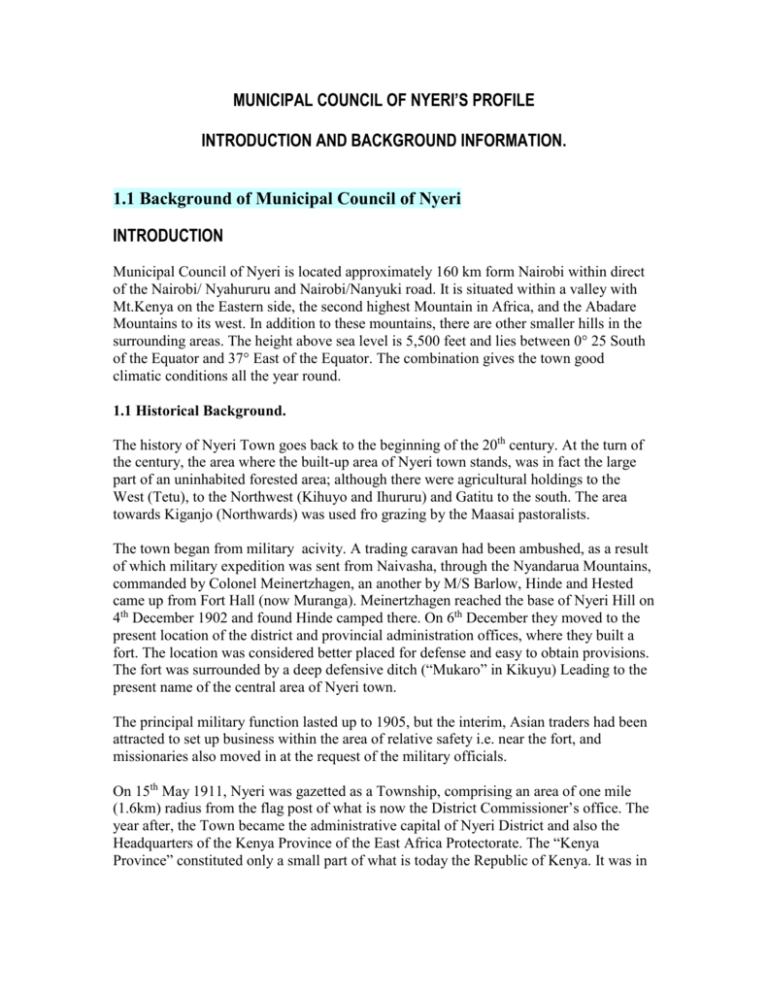
MUNICIPAL COUNCIL OF NYERI’S PROFILE INTRODUCTION AND BACKGROUND INFORMATION. 1.1 Background of Municipal Council of Nyeri INTRODUCTION Municipal Council of Nyeri is located approximately 160 km form Nairobi within direct of the Nairobi/ Nyahururu and Nairobi/Nanyuki road. It is situated within a valley with Mt.Kenya on the Eastern side, the second highest Mountain in Africa, and the Abadare Mountains to its west. In addition to these mountains, there are other smaller hills in the surrounding areas. The height above sea level is 5,500 feet and lies between 0° 25 South of the Equator and 37° East of the Equator. The combination gives the town good climatic conditions all the year round. 1.1 Historical Background. The history of Nyeri Town goes back to the beginning of the 20th century. At the turn of the century, the area where the built-up area of Nyeri town stands, was in fact the large part of an uninhabited forested area; although there were agricultural holdings to the West (Tetu), to the Northwest (Kihuyo and Ihururu) and Gatitu to the south. The area towards Kiganjo (Northwards) was used fro grazing by the Maasai pastoralists. The town began from military acivity. A trading caravan had been ambushed, as a result of which military expedition was sent from Naivasha, through the Nyandarua Mountains, commanded by Colonel Meinertzhagen, an another by M/S Barlow, Hinde and Hested came up from Fort Hall (now Muranga). Meinertzhagen reached the base of Nyeri Hill on 4th December 1902 and found Hinde camped there. On 6th December they moved to the present location of the district and provincial administration offices, where they built a fort. The location was considered better placed for defense and easy to obtain provisions. The fort was surrounded by a deep defensive ditch (“Mukaro” in Kikuyu) Leading to the present name of the central area of Nyeri town. The principal military function lasted up to 1905, but the interim, Asian traders had been attracted to set up business within the area of relative safety i.e. near the fort, and missionaries also moved in at the request of the military officials. On 15th May 1911, Nyeri was gazetted as a Township, comprising an area of one mile (1.6km) radius from the flag post of what is now the District Commissioner’s office. The year after, the Town became the administrative capital of Nyeri District and also the Headquarters of the Kenya Province of the East Africa Protectorate. The “Kenya Province” constituted only a small part of what is today the Republic of Kenya. It was in 1913 that the old “Town” borders were established, remaining Nyeri Town’s borders for the next sixty years. In 1927, the railway reached Kiganjo, which had been chosen as the Nyeri railroad station, both due to its topographical advantages and its closer proximity to the settlers’ farmlands which had developed to the North, after the 1912 relocation of the original Masai inhabitants to areas around Narok. After boundary changes in the Kenya colony, Nyeri Town became the capital of the Kikuyu province in 1934. Some more changes occurred, so that in 1933, Nyeri was the capital of the then Central province, which included Nanyuki, Meru to the North, and Nairobi to the south, and the Machakos/ Kitui areas to the East. This remained the case until the boundary revisions in 1961 to 1965, where Nyeri remained the administrative capital of much smaller central region and then Central Province. For all its formative years, the District Commissioner administered Nyeri Town. In June 1954, the Nyeri Urban District Council was created. It was a structure whose function was to assist the District Commissioner, and exercised its functions in Nyeri, Kiganjo and Mweiga. In 1963 however, the Urban Council assumed a representative nature with election of councilors. Nyeri town fully became a municipality in May 1971, when the first Mayor was elected. The elevation was accompanied by a ten-fold increase in the Town area, from the area defined by 1913 survey and distribution of plots. As seen from the above brief history, the “birth” of Nyeri was from a military function, but this was quickly replaced by an administrative role. Commercial development started with trading stores located in the shadow of the fort, but this was gradually transformed into the only center of commerce for northern farmlands (until Nanyuki took some of the business) as well as a market center for nearby small scale farming. Nyeri was elevated to Municipal Council in 1971 (vide Gazette Notice No. 61,1971) covering an area of about 72sq. km. Before this time, it used to exist as an Urban Council covering only 8sq.km, which included areas surrounding the town center (the present Central Business District (C.B.D) area. Today, Nyeri Municipality covers an area of 200sq. km. Its borders coincide with Nyeri Town constituency boundaries. Nyeri can be defined as an urban/rural town, as about 50 per cent of its present area, is rural in nature, with rich agricultural hinterland owned and managed by small scale farmers growing mainly tea and coffee as cash crops. There are vast coffee plantations less than a Kilometer from the Tow Center around Kingongo and Muringato. Mandate The main function of the Municipal Council of Nyeri is as outlined in the Local Government Act Cap 265, section 151 to 199 of the laws of Kenya Core Functions The main function of the Municipal Council of Nyeri includes the following: Garbage Collection Cleaning of the town, markets and trading centers Solid waste and drainage system management Approval of development plans Survey and beckoning of land Road maintenance (opening, grading and gravelling of town roads) Maintenance of existing infrastructure Building and maintaining markets Street lighting Housing Leasing slaughter house service Environmental conservation, tree planting and beautification Provision of recreational facilities HIV/AIDS Programme Health and human services (schools, dispensaries-health centers) etc. Enforcement of Council By-Laws Vision To become the leading Municipality in the East African Region in provision of quality and sustainable services to all. Mission To provide efficient, effective and sustainable services through the use of competent Human Resource, good governance, appropriate technology, mobilization of resources and embracing stakeholders’ participation. Core Values (i) Service Excellence We value our stakeholders and strive to exceed their expectations through excellent service delivery (ii) Team Work We practice, Team work to optimize the synergies of individual and collective human resource talent (iii) Efficiency We try as much as possible to optimize our resources in order to deliver quality (iv) Integrity We uphold virtues of integrity through honesty, confidentiality and fairness in discharge our responsibility. (v) Accountability We strive to be responsible stewards of all resources entrusted to us in a professional and transparent manner. (vi) Social responsibilities We endeavor to be socially responsible to our stakeholders and society at large and pursue our goals through socially acceptable practices that preserve the environment promote social and economic development to engaging in practices that ensure competitiveness in Local Authorities setting. Policy Priorities The following are the policy priorities (a) (b) (c) (d) (e) (f) (g) Solid waste and drainage system management Maintenance of existing infrastructure Cleaning of the town, markets and trading centers Garbage collection Leasing slaughter house services HIV/AIDS Programmes Health and human services (Schools, dispensaries-health centers). ORGANISATION AND MANAGEMENT The administrative structure of Municipal Council of Nyeri is divided into the policy arm (headed by the Chairman of the Council) and the administrative arm (headed by the Clerk to Council). The policy arm functions through committees that make council policies which are validated by the full Council. The Administrative arm functions through the following departments headed by the Town Clerk. Organizational Structure (part 1) 1: EXECUTIVE WING TOWN CLERK TOWN TREASURER DEPUTY TOWN CLERK DEPUTY TOWN TREASURER SENIOR INTERNAL AUDITOR PRINCIPAL ADMINISTARTIVE OFFICER ACCOUNTANTS ESTABLISHMENT OFFICER REVENUE OFFICERS ADMINISTRATIVE OFFICER PROCUREMENT OFFICER REGISTRY SENIOR COMMITTEE CLERK INSPECTORATE TOWN ENGINEER SOCIAL WELFARE WORKS OFFICER SOCIAL WORKER SURVEYOR COMM. DEV. TRAINER ROADS & BUILDING FOREMAN GARAGE FIRE PREVENTION SPORTS & GAMES HIV/AIDS PROGRAMME MAYOR’S OFFICE 2: CIVIC WING. The civic arm of the council provides the policy and governance framework. FULL COUNCIL FINANCE, STAFF & GENERAL PURPOSES WORKS AND TOWN PLANNING PUBLIC HEALTH AND ENVIRONMENT HOUSING EDUCATION & SOCIAL SERVICES WATER AND SEWARAGE HIV-AIDS AND STREET CHILDREN
